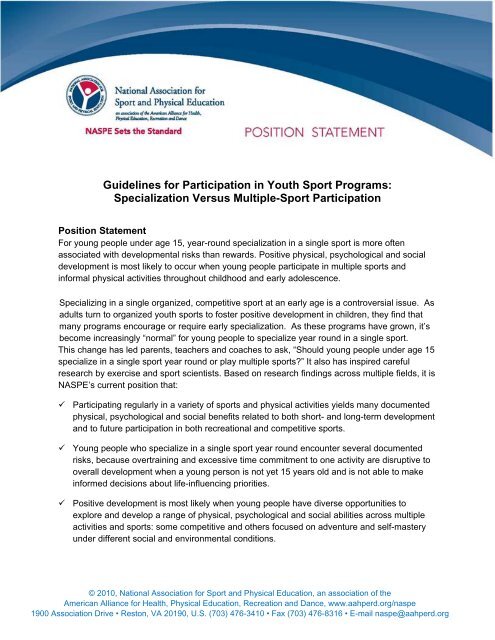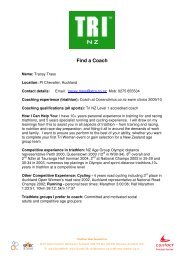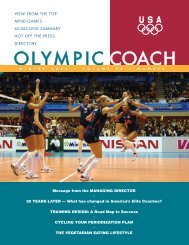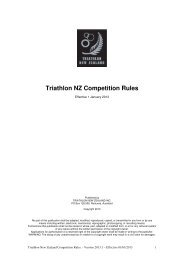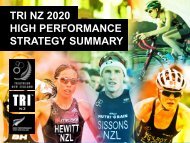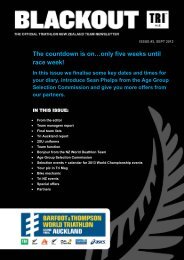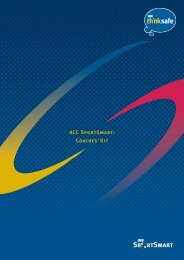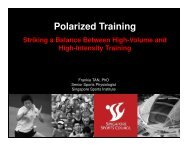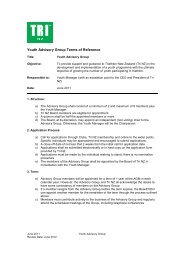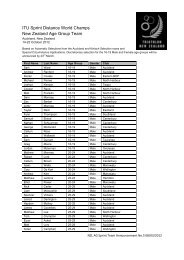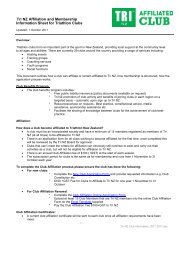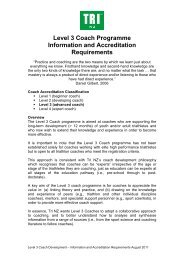Guidelines for Participation in Youth Sport Programs ... - AAHPERD
Guidelines for Participation in Youth Sport Programs ... - AAHPERD
Guidelines for Participation in Youth Sport Programs ... - AAHPERD
You also want an ePaper? Increase the reach of your titles
YUMPU automatically turns print PDFs into web optimized ePapers that Google loves.
<strong>Guidel<strong>in</strong>es</strong> <strong>for</strong> <strong>Participation</strong> <strong>in</strong> <strong>Youth</strong> <strong>Sport</strong> <strong>Programs</strong>:Specialization Versus Multiple-<strong>Sport</strong> <strong>Participation</strong>Position StatementFor young people under age 15, year-round specialization <strong>in</strong> a s<strong>in</strong>gle sport is more oftenassociated with developmental risks than rewards. Positive physical, psychological and socialdevelopment is most likely to occur when young people participate <strong>in</strong> multiple sports and<strong>in</strong><strong>for</strong>mal physical activities throughout childhood and early adolescence.Specializ<strong>in</strong>g <strong>in</strong> a s<strong>in</strong>gle organized, competitive sport at an early age is a controversial issue. Asadults turn to organized youth sports to foster positive development <strong>in</strong> children, they f<strong>in</strong>d thatmany programs encourage or require early specialization. As these programs have grown, it’sbecome <strong>in</strong>creas<strong>in</strong>gly “normal” <strong>for</strong> young people to specialize year round <strong>in</strong> a s<strong>in</strong>gle sport.This change has led parents, teachers and coaches to ask, “Should young people under age 15specialize <strong>in</strong> a s<strong>in</strong>gle sport year round or play multiple sports?” It also has <strong>in</strong>spired carefulresearch by exercise and sport scientists. Based on research f<strong>in</strong>d<strong>in</strong>gs across multiple fields, it isNASPE’s current position that: Participat<strong>in</strong>g regularly <strong>in</strong> a variety of sports and physical activities yields many documentedphysical, psychological and social benefits related to both short- and long-term developmentand to future participation <strong>in</strong> both recreational and competitive sports. Young people who specialize <strong>in</strong> a s<strong>in</strong>gle sport year round encounter several documentedrisks, because overtra<strong>in</strong><strong>in</strong>g and excessive time commitment to one activity are disruptive tooverall development when a young person is not yet 15 years old and is not able to make<strong>in</strong><strong>for</strong>med decisions about life-<strong>in</strong>fluenc<strong>in</strong>g priorities. Positive development is most likely when young people have diverse opportunities toexplore and develop a range of physical, psychological and social abilities across multipleactivities and sports: some competitive and others focused on adventure and self-masteryunder different social and environmental conditions.© 2010, National Association <strong>for</strong> <strong>Sport</strong> and Physical Education, an association of theAmerican Alliance <strong>for</strong> Health, Physical Education, Recreation and Dance, www.aahperd.org/naspe1900 Association Drive • Reston, VA 20190, U.S. (703) 476-3410 • Fax (703) 476-8316 • E-mail naspe@aahperd.org
2 Specialization Versus Multiple-<strong>Sport</strong> <strong>Participation</strong> (Cont.) Positive development is seldom achieved when adults encourage specialization bysupport<strong>in</strong>g programs with seasons longer than three months and when they verbalizeexpectations that young people should participate <strong>in</strong> associated camps and cl<strong>in</strong>ics, privatelessons and practices throughout much of the year. Us<strong>in</strong>g <strong>in</strong>tense and specialized sport participation as a strategy to w<strong>in</strong> championships andscholarships, and to create athletic careers often is counterproductive because it frequentlycauses burnout and underm<strong>in</strong>es overall personal development throughout childhood andadolescence. The motivation to achieve excellence is highest when young people have experiences <strong>in</strong>multiple sports and can make <strong>in</strong><strong>for</strong>med choices about the sports <strong>in</strong> which they want tospecialize dur<strong>in</strong>g adolescence.There<strong>for</strong>e, NASPE recommends that parents, teachers and coaches:1. Encourage young people to try a range of sports so that they can discover what they enjoyand can develop the overall physical competence to maximize their success <strong>in</strong> the sportsthey choose to play after reach<strong>in</strong>g age 15.2. Ensure that young people have a wide range of experiences and relationships across manyorganized sports (structured play) and <strong>in</strong><strong>for</strong>mal games that are organized and ma<strong>in</strong>ta<strong>in</strong>ed bythe young people themselves.3. Evaluate youth sports programs <strong>in</strong> terms of how effectively they produce positive selfesteem,self-efficacy and perceptions of competence among young people.4. Support and encourage young people to participate <strong>in</strong> sport programs that focus ondevelop<strong>in</strong>g fundamental movement skills that lead to <strong>in</strong>creased skill and ability (e.g., propertechnique <strong>for</strong> runn<strong>in</strong>g, throw<strong>in</strong>g, stopp<strong>in</strong>g and chang<strong>in</strong>g directions).5. In<strong>for</strong>m young people about the sport participation options available to them, encourage themto diversify their experiences <strong>in</strong> sport and physical activities, and enable them to makeparticipation choices based on knowledge of the risks associated with specialization,particularly <strong>for</strong> those younger than age 15.6. Organize and support youth sports <strong>in</strong> which practices and competitions focus on learn<strong>in</strong>gnew skills, ga<strong>in</strong><strong>in</strong>g confidence <strong>in</strong> one’s abilities and foster<strong>in</strong>g a lifelong love of physicalactivities among all participants regardless of their level of physical development and tra<strong>in</strong><strong>in</strong>gexperience.7. Reduce overuse <strong>in</strong>juries and <strong>in</strong>crease overall physical competence and well-be<strong>in</strong>g byemphasiz<strong>in</strong>g the development of sport skills (agility, balance and speed), as well as aerobicfitness and flexibility, and muscle strength and power.8. Reduce burnout, boredom and dropp<strong>in</strong>g out from sports, and maximize the probability ofpersonal development and success <strong>in</strong> a chosen sport by discourag<strong>in</strong>g specialization <strong>in</strong> onesport until a young person can make a fully <strong>in</strong><strong>for</strong>med decision, usually at about age 15.© 2010, National Association <strong>for</strong> <strong>Sport</strong> and Physical Education, an association of theAmerican Alliance <strong>for</strong> Health, Physical Education, Recreation and Dance, www.aahperd.org/naspe1900 Association Drive • Reston, VA 20190, U.S. (703) 476-3410 • Fax (703) 476-8316 • E-mail naspe@aahperd.org
3 Specialization Versus Multiple-<strong>Sport</strong> <strong>Participation</strong> (Cont.)9. Seek and support coaches who can expla<strong>in</strong> how their sports improve overall physical fitness,and who also make it clear that athletic scholarships are not as plentiful or comprehensive asmost people th<strong>in</strong>k, and that most scholarships cover only part of college expenses.10. Emphasize enjoyment and the love of movement and physical challenges so that youngpeople will <strong>in</strong>tegrate physical activity and sport participation <strong>in</strong>to their lives and be motivatedto ma<strong>in</strong>ta<strong>in</strong> overall fitness and well-be<strong>in</strong>g throughout the course of their lives.Those recommendations are based on research conducted primarily <strong>in</strong> the physical sciences,psychology and sociology. The most relevant and important f<strong>in</strong>d<strong>in</strong>gs from each of these fields aresummarized here:Research F<strong>in</strong>d<strong>in</strong>gs on Physical Development• Specializ<strong>in</strong>g <strong>in</strong> a s<strong>in</strong>gle sport is associated with high rates of overuse <strong>in</strong>juries caused byconsistently <strong>in</strong>tense, repetitive physical movements that stress the bodies of young peopleunevenly, foster unbalanced muscle development and compromise bone development.Common manifestations of these <strong>in</strong>juries: Little League elbow, tendon and ligamentdamage, stress fractures, <strong>in</strong>juries to develop<strong>in</strong>g jo<strong>in</strong>ts and jo<strong>in</strong>t surfaces, and <strong>in</strong>juries to theimmature sp<strong>in</strong>e.• Involv<strong>in</strong>g oneself across a range of sports — with breaks and needed recuperative timebetween sport seasons — is the most effective way to enhance long-term health and skilldevelopment, as well as to enable young people to meet the physical demands ofcompetitive sport.• The most effective sport development and tra<strong>in</strong><strong>in</strong>g programs around the world discourageyear-round specialization <strong>in</strong> a s<strong>in</strong>gle organized sport and, generally, use cross-tra<strong>in</strong><strong>in</strong>gmethods to develop a full range of skills to prepare young people <strong>for</strong> specialization at age 15and older. Exceptions occur only <strong>in</strong> sports with judg<strong>in</strong>g criteria that favor the flexibility andartistic l<strong>in</strong>es of prepubescent bodies, even though those criteria encourage <strong>for</strong>ms of tra<strong>in</strong><strong>in</strong>gthat jeopardize athletes’ long-term health and well-be<strong>in</strong>g.Research Summary: Physical DevelopmentParticipat<strong>in</strong>g <strong>in</strong> many sports and physical activities maximizes physiological developmentamong young people. Grow<strong>in</strong>g bodies are predisposed physiologically to non-specializedphysical activities; there<strong>for</strong>e, physical development and success <strong>in</strong> sports are enhanced byparticipat<strong>in</strong>g <strong>in</strong> multiple sports on a schedule that allows <strong>for</strong> periods of active rest andrecuperation throughout the year. Specialization <strong>in</strong> a s<strong>in</strong>gle sport is more likely to <strong>in</strong>hibit ordistort balanced physical development, restrict skill-development opportunities and underm<strong>in</strong>ethe <strong>for</strong>ms of sport participation that maximize lifelong fitness and well-be<strong>in</strong>g.© 2010, National Association <strong>for</strong> <strong>Sport</strong> and Physical Education, an association of theAmerican Alliance <strong>for</strong> Health, Physical Education, Recreation and Dance, www.aahperd.org/naspe1900 Association Drive • Reston, VA 20190, U.S. (703) 476-3410 • Fax (703) 476-8316 • E-mail naspe@aahperd.org
4 Specialization Versus Multiple-<strong>Sport</strong> <strong>Participation</strong> (Cont.)Research F<strong>in</strong>d<strong>in</strong>gs Related to Psychological Development• Participat<strong>in</strong>g <strong>in</strong> multiple and diverse physical activities promotes self-esteem, self-efficacyand perceptions of competence among young people and enables them to learn their fullrange of abilities and make <strong>in</strong><strong>for</strong>med choices about the sports <strong>in</strong> which they are most likelyto succeed.• Young people are most likely to develop a sense of self-mastery when they participateacross multiple sports; whereas year-round specialization <strong>in</strong> a s<strong>in</strong>gle sport prior to age 15often restricts the experiences that young people require to make <strong>in</strong><strong>for</strong>med choices aboutsport participation.• Develop<strong>in</strong>g positive identities requires a diversity of experiences and relationships dur<strong>in</strong>gchildhood and adolescence, and participat<strong>in</strong>g <strong>in</strong> multiple sports <strong>in</strong>creases experiences andrelationships with peers and authority figures <strong>in</strong> ways that prepare young people <strong>for</strong> lifelongenjoyment of sports and engaged citizenship.• Burnout ⎯ stress-<strong>in</strong>duced withdrawal from a sport that one enjoyed previously ⎯ isassociated with a sense that one’s capabilities cannot meet <strong>in</strong>creas<strong>in</strong>gly demand<strong>in</strong>gexpectations and that <strong>in</strong>tense, year-round participation <strong>in</strong> a s<strong>in</strong>gle sport <strong>in</strong>terferes withoverall personal and social development.• Young people under age 15 are most likely to develop the <strong>in</strong>tr<strong>in</strong>sic motivation that susta<strong>in</strong>slong-term sport participation ⎯ as well as a quest <strong>for</strong> excellence <strong>in</strong> particular sports ⎯ whenthey play multiple sports rather than specializ<strong>in</strong>g <strong>in</strong> a s<strong>in</strong>gle sport.Research Summary: Psychological DevelopmentLearn<strong>in</strong>g a wide range of physical skills and be<strong>in</strong>g exposed to diverse experiences andrelationships promotes psychological development among young people. Play<strong>in</strong>g multiplesports expands their options and choices as they grow older, and it fosters the <strong>in</strong>tr<strong>in</strong>sicmotivation that susta<strong>in</strong>s lifelong sports participation and leads to achiev<strong>in</strong>g excellence <strong>in</strong>particular sports.Research F<strong>in</strong>d<strong>in</strong>gs Related to Social Development• When young people play organized, competitive sports and lack time or opportunities toparticipate <strong>in</strong> player-controlled <strong>in</strong><strong>for</strong>mal games, they miss important learn<strong>in</strong>g experiencesrelated to creativity, <strong>in</strong>novation, conflict resolution, decision-mak<strong>in</strong>g, group skills and selfadvocacythat are less likely to be learned <strong>in</strong> adult-controlled sports.• When young people participate regularly <strong>in</strong> <strong>in</strong><strong>for</strong>mal games and sports, they are less likely todrop out of organized sport programs than their peers who specialize <strong>in</strong> a s<strong>in</strong>gle sport from ayoung age.• Elite athlete development and lifelong motivation to play sports is promoted most effectivelywhen young people play <strong>in</strong><strong>for</strong>mal games dur<strong>in</strong>g childhood and also play multiple sports untilage 15.© 2010, National Association <strong>for</strong> <strong>Sport</strong> and Physical Education, an association of theAmerican Alliance <strong>for</strong> Health, Physical Education, Recreation and Dance, www.aahperd.org/naspe1900 Association Drive • Reston, VA 20190, U.S. (703) 476-3410 • Fax (703) 476-8316 • E-mail naspe@aahperd.org
5 Specialization Versus Multiple-<strong>Sport</strong> <strong>Participation</strong> (Cont.)• Intense and exclusive specialization <strong>in</strong> a sport usually occurs <strong>in</strong> youth sport programs thatdepend on year-round <strong>in</strong>come to pay <strong>for</strong> facilities and coaches; such programs are seldomeffective <strong>in</strong> promot<strong>in</strong>g overall development among young people.• Allow<strong>in</strong>g young people to specialize <strong>in</strong>tensely and year round <strong>in</strong> a s<strong>in</strong>gle sport usuallyimmerses their families <strong>in</strong> team cultures with<strong>in</strong> which parental moral worth depends on<strong>in</strong>vest<strong>in</strong>g so many family resources to the sport that the diversity of a young person’sphysical activities, experiences and relationships is compromised.Research Summary: Social DevelopmentSocial development among young people is maximized when they play multiple sports be<strong>for</strong>eage 15. This expands their <strong>in</strong>terests, identities and experiences, and provides a basis <strong>for</strong><strong>in</strong><strong>for</strong>med sport participation choices beyond age 15. When a young person plays multiplesports, parents are less likely to be drawn <strong>in</strong>to a specific sport culture <strong>in</strong> which their children’soverall development is not the highest priority.For more <strong>in</strong><strong>for</strong>mation on effective sport programs <strong>for</strong> youths, visit www.naspe.org/multisport.Position Statement Task ForceJay Coakley, Ph.D., University of Colorado at Colorado Spr<strong>in</strong>gsMichael P. Sheridan, Ph.D., Tri-Valley (Ohio) School DistrictRick Howard, School District of PhiladelphiaTim Graham, Tumwater (Wash<strong>in</strong>gton) High SchoolAvery Faigenbaum, Ed.D.,The College of New JerseyReferencesNote: These references provide recent and comprehensive research and research summariesrelated to specialization versus multiple-sport participation among young people.Auv<strong>in</strong>en, J., Tammel<strong>in</strong>, T., Taimela, S., Zitt<strong>in</strong>g, P., Mutanen, P. & Karpp<strong>in</strong>en, J. 2008.Musculoskeletal pa<strong>in</strong>s <strong>in</strong> relation to different sport and exercise activities <strong>in</strong> youth. Medic<strong>in</strong>eand Science <strong>in</strong> <strong>Sport</strong>s and Exercise, 40, 1890-1900.Baker, J. & Robertson-Wilson, J. 2003. On the risks of early sports specialization <strong>in</strong> sport.Physical and Health Education Journal, 69, 4-8.Barnett, L., Van Beurden, E., Morgan, P., Brooks, L. & Beard, J. 2008. Does childhood motorskill proficiency predict adolescent fitness? Medic<strong>in</strong>e and Science <strong>in</strong> <strong>Sport</strong>s and Exercise,40, 2137-2144.© 2010, National Association <strong>for</strong> <strong>Sport</strong> and Physical Education, an association of theAmerican Alliance <strong>for</strong> Health, Physical Education, Recreation and Dance, www.aahperd.org/naspe1900 Association Drive • Reston, VA 20190, U.S. (703) 476-3410 • Fax (703) 476-8316 • E-mail naspe@aahperd.org
6 Specialization Versus Multiple-<strong>Sport</strong> <strong>Participation</strong> (Cont.)Brady, F. 2004. Children's organized sports. A Developmental perspective. Journal of PhysicalEducation Recreation and Dance, 75, 35-41.Bloom, B. 1985. Develop<strong>in</strong>g talent <strong>in</strong> young people. New York: Ballant<strong>in</strong>e Books.Busseri, M.A., Rose-Krasnor, L., Willoughby, T. & Chalmers, H. 2006. A longitud<strong>in</strong>alexam<strong>in</strong>ation of breadth and <strong>in</strong>tensity of youth activity <strong>in</strong>volvement and successfuldevelopment. Developmental Psychology, 42: 1313-1326.Chudacoff, H. 2007. Children at play: An American history. New York, NY: New York UniversityPress.Coakley, J. 2009. <strong>Sport</strong>s <strong>in</strong> society: Issues and controversies (10th ed.). New York: McGraw-Hill.Committee on <strong>Sport</strong>s Medic<strong>in</strong>e and Fitness 2000. Intensive tra<strong>in</strong><strong>in</strong>g and sports specialization <strong>in</strong>young athletes. Pediatrics, 106, 154-157.Côté, J., Lidor, R., & Hack<strong>for</strong>t, D. 2009. ISSP Position Stand: To sample or to specialize? Sevenpostulates about youth sport activities that lead to cont<strong>in</strong>ued participation and eliteper<strong>for</strong>mance. International Journal of <strong>Sport</strong> and Exercise Psychology, 7, 1: 7-17.Council on <strong>Sport</strong>s Medic<strong>in</strong>e and Fitness 2007. Overuse <strong>in</strong>juries, overtra<strong>in</strong><strong>in</strong>g, and burnout <strong>in</strong>children and adolescent athletes. Pediatrics, 119, 1242-1245.Elk<strong>in</strong>d, D. 2008. The power of play: Learn<strong>in</strong>g what comes naturally. Da Capo Lifelong Books.Faigenbaum, A., Kraemer, W., Blimkie, C., Jeffreys, I., Micheli, L., Nitka, M. & Rowland, T.2009. <strong>Youth</strong> resistance tra<strong>in</strong><strong>in</strong>g: Updated position statement paper from the NationalStrength and Condition<strong>in</strong>g Association. Journal of Strength and Condition<strong>in</strong>g Research, 23,S60-S79.Faigenbaum, A. & Westcott, W. 2009. <strong>Youth</strong> strength tra<strong>in</strong><strong>in</strong>g, Champaign, IL, Human K<strong>in</strong>etics.Farrey, T. (2008). Game on: The All-American race to make champions of our children. NewYork, NY: ESPN Books.Fraser-Thomas, J., Cote, J. & Deak<strong>in</strong>, J. 2008. Exam<strong>in</strong><strong>in</strong>g adolescent sport drop-out andprolonged engagement from a developmental perspective. Journal of Applied <strong>Sport</strong>Psychology, 20, 318-333.Fraser-Thomas, J. & Côté, J. 2006. <strong>Youth</strong> <strong>Sport</strong>s: Implement<strong>in</strong>g F<strong>in</strong>d<strong>in</strong>gs and Mov<strong>in</strong>g Forwardwith Research. Athletic Insight: The Onl<strong>in</strong>e Journal of <strong>Sport</strong> Psychology:www.athletic<strong>in</strong>sight.com/Vol8Iss3/<strong>Youth</strong><strong>Sport</strong>s.htm.Gould, D. & Carson, S. 2004. Fun and games? Myths surround<strong>in</strong>g the role of youth sports <strong>in</strong>develop<strong>in</strong>g Olympic champions. <strong>Youth</strong> Studies Australia, 23, 19-26.© 2010, National Association <strong>for</strong> <strong>Sport</strong> and Physical Education, an association of theAmerican Alliance <strong>for</strong> Health, Physical Education, Recreation and Dance, www.aahperd.org/naspe1900 Association Drive • Reston, VA 20190, U.S. (703) 476-3410 • Fax (703) 476-8316 • E-mail naspe@aahperd.org
7 Specialization Versus Multiple-<strong>Sport</strong> <strong>Participation</strong> (Cont.)Gould, D, Tuffey, S., Udry, E., & Loehr, J. 1996. Burnout <strong>in</strong> competitive junior tennis players: II.Qualitative analysis. The <strong>Sport</strong> Psychologist, 10, 322-340.Renstrom, P., Ljungqvist, A., Arendt, E., Beynnon, B., Fukubayashi, T., Garrett, W., Georgoulis,T., Hewett, T., Johnson, R., Krosshaug, T., Mandelbaum, B., Micheli, L., Myklebust, G.,Roos, E., Roos, H., Schamasch, P., et al. 2008. Non-contact ACL <strong>in</strong>juries <strong>in</strong> femaleathletes: an International Olympic Committee current concepts statement. British Journal of<strong>Sport</strong>s Medic<strong>in</strong>e, 42, 394-412.Stodden, D., Goodway, J., Langendorfer, S., Robertson, M., Rudisill, M. & Garcia, C. 2008. Adevelopmental perspective on the role of motor skill competence <strong>in</strong> physical activity: Anemergent relationship. Quest, 60, 290-306.Strong, W.B., Mal<strong>in</strong>a, R.M., Blimkie, C.J., Daniels, S.R., Dishman, R.K., Gut<strong>in</strong>, B.,Hergenroeder, A.C., Must, A., Nixon, P.A., Pivarnik, J.M., Rowland, T., Trost, S. & Trudeau,F. 2005. Evidence-based physical activity <strong>for</strong> school-age youth. Journal of Pediatrics, 146,732-7.Vallerand, R. J. 2007. Intr<strong>in</strong>sic and extr<strong>in</strong>sic motivation <strong>in</strong> sport and physical activity: A reviewand a look at the future. In Gershon Tenenbaum & Robert C. Eklund, eds. Handbook ofsport psychology (3rd edition; pp. 59-83). Hoboken, NJ: Wiley.Wall, M., & Côté, J. 2007. Developmental activities that lead to dropout and <strong>in</strong>vestment <strong>in</strong> sport.Physical Education and <strong>Sport</strong> Pedagogy, 12, 1: 77–87.Weirsma, L.D. 2000. Risks and benefits of youth sport specialization. Pediatric ExerciseScience, 12: 13–22.National Association <strong>for</strong> <strong>Sport</strong> and Physical EducationAn association of theAmerican Alliance <strong>for</strong> Health, Physical Education, Recreation and Dance1900 Association DriveReston, Va. 20191(p) 703-476-3410(f) 703-476-8316http://www.naspe<strong>in</strong>fo.org/Suggested Citation:National Association <strong>for</strong> <strong>Sport</strong> and Physical Education. (2010). <strong>Guidel<strong>in</strong>es</strong> <strong>for</strong> participation <strong>in</strong>youth sport programs: Specialization versus multi-sport participation [Position statement]. Reston, VA:Author.© 2010, National Association <strong>for</strong> <strong>Sport</strong> and Physical Education, an association of theAmerican Alliance <strong>for</strong> Health, Physical Education, Recreation and Dance, www.aahperd.org/naspe1900 Association Drive • Reston, VA 20190, U.S. (703) 476-3410 • Fax (703) 476-8316 • E-mail naspe@aahperd.org


